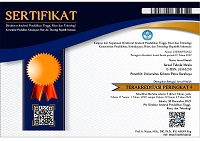Separasi Aliran Tiga Dimensi pada Kaskade Kompressor Aksial dengan Sudu Berbeda Kelengkungan
Keywords:
Three dimension flow separation, blockage effect, secondary losses, saddle point, horse shoe vortex.Abstract
In an axial compressor, it is common to find out a complicated secondary flow (three dimensional flows) which occurred on interaction area between blade boundary layer and hub/ casing boundary layer. This phenomenon to some extent can decrease the compressor pressure. It is due to disturbance generated by this secondary flow affected the flow characteristics on the interaction area. Moreover, it can create a blockage effect and secondary losses which ultimately decreases the compressor pressure. As it has been known, the axial compressor secondary losses plays major parts (50%) on total hydraulic losses while other losses contributed to the total hydraulic losses are annulus wall friction, friction and two dimensional separations on the axial compressor blade profiles. Hence, more serious effort should be devoted to increase the axial compressor performance by reducing the secondary losses. From previous research, geometrical arrangement and cascade compressor configuration have been proved to contribute on development of the secondary flow in an axial compressor. In this paper, the authors conducted three dimension separation flow characteristic visualization in blade passage. The visualization is represented by flow visualization, velocity vector distribution, pressure coefficient distribution (Cp) and pressure losses coefficient distribution (v). The authors also investigated some parameters that affected the cascade compressor configuration performance. One of the parameter is blade camber. The experiment was conducted on blade profile of British 9C7/32,5C50 and 9C7/32,5C50. Those profiles are similar in their geometry but have different camber. Wind tunnel experiments have been conducted with velocity of 20 m/s (Rel = 1.6 x 105). Flow visualization was performed by method of oil flow visualization (OFV) using a mixture compound of titanium powder and bio oil. The pressure distributions along the blades were measured using pressure transducer and inclined manometer. Computational Fluid Dynamics was employed to modeling and analyzing the velocity vector with setting parameter of 3d-dp, segregated, RNG k-ε. By using those methods, the authors capable to visualize flow separation inside blade passage and cascade output. In the cascade configuration, blade camber with fixed load angle has a significant role for the development of three dimensional flow separation (horse shoe vortex appears) in front of the leading edge. This phenomenon was started by the appearance of forward saddle point. This forward saddle point will move if the camber angle is changed. The increasing camber angle from θ = 32.5o to θ = 42.5o shifted the forward saddle point and changed three dimension separation line width. For blade airfoil 9C7/42,5C50, the position of forward saddle point is far away in front of leading edge but almost in line with blade chord line. On the other hand for blade cascade with 9C7/32,5C50, the position of forward saddle point is much closer to the leading edge but far below the blade chord line. The upper shifting of the forward saddle point for blade with higher camber also pushed the low pressure area on the upper side zone further back. It also pushed the high pressure area on lower side in the same direction as the one on the upper side. This phenomenon subsequently increasing the intensity of cross passage flow at the back side of blade passage and curl flow at the trailing edge. This increasing intensity of the secondary flow near hub junction will ultimately increase the blockage effect and total pressure losses. Abstract in Bahasa Indonesia: Pada kompresor aksial, fenomena aliran sekunder tiga dimensi yang sangat rumit terjadi pada interaksi antara lapisan batas sudu dengan lapisan batas hub/casing. Akibat yang ditimbulkan fenomena ini adalah terpengaruhnya karakteristik medan aliran di daerah interaksi tersebut yang pada akhirnya berkaitan dengan efek penyumbatan (blockage effect) serta kerugian sekunder (secondary losses) yang dapat menurunkan tekanan kompresor. Kerugian sekunder diketahui menyumbang sekitar 50% dari total kerugian hidrolis yang terjadi pada kompresor aksial, sementara kerugian akibat friksi pada dinding annulus serta kerugian friksi dan separasi dua dimensi pada profil berkontribusi 30% dan 20%. Dengan demikian, upaya serius untuk mengurangi kerugian aliran sekunder akan banyak membantu meningkatkan kinerja (efisiensi) kompresor aksial. Berdasarkan kajian pustaka beberapa hasil eksperimen, bentuk geometri dan susunan konfigurasi kaskade (cascade) kompresor diduga mempunyai pengaruh signifikan terhadap terbentuknya aliran sekunder. Pada penelitian ini dilakukan visualisasi karakteristik (struktur) separasi aliran tiga dimensi di dalam lorong sudu berupa visualisasi jejak aliran, distribusi vektor kecepatan, distribusi koefisien tekanan (Cp) dan distribusi koefisien kerugian tekanan (v). Parameter yang berpengaruh terhadap susunan konfigurasi kaskade adalah perubahan kelengkungan sudu, sedangkan profil sudu yang digunakan adalah profil sudu British 9C7/32,5C50 dan 9C7/42,5C50 yang secara geometris mirip satu sama lain namun memiliki kelengkungan berbeda. Eksperimen dilakukan pada lorong anginh dengan kecepatan 20 m/s (Rel = 1,6 x 105) dan visualisasi aliran dengan teknik oil flow visualization (OFV) menggunakan campuran serbuk titanium dan minyak nabati. Pengukuran tekanan menggunakan pressure transducer dan inclined manometer, sedangkan Computational Fluid Dynamics (CFD) untuk mempresentasikan vektor kecepatan aliran menggunakan perangkat lunak Fluent 6.0, 3d-dp, segregated, RNG k-ε. Hasil penelitian terbukti mampu memvisualisasikan separasi aliran di dalam lorong sudu maupun di keluaran kaskade. Pada susunan konfigurasi kaskade, kelengkungan sudu pada sudut pembebanan yang tetap, sangat berpengaruh terhadap formasi separasi aliran tiga dimensi (terbentuknya horse shoe vortex) di depan leading edge yang diawali dengan terbentuknya forward saddle point. Pada kaskade 9C7/42,5C50 posisi forward saddle point lebih jauh di depan leading edge namun hampir segaris terhadap chord line sudu, sebaliknya untuk kaskade 9C7/32,5C50 posisi forward saddle point lebih dekat terhadap leading edge tetapi lebih jauh di bawah chord line sudu. Bergesernya lokasi saddle point lebih ke atas untuk sudu yang lebih lengkung juga berakibat bergesernya daerah tekanan rendah pada zona upper side dan daerah tekanan tinggi pada zona lower side lebih ke belakang. Hal inilah yang mendorong penguatan intensitas cross passage flow pada bagian belakang blade passage dan curl flow pada trailing edge sudu. Penguatan intensitas aliran sekunder di dekat hub junction tersebut, berakibat pada menguatnya penyumbatan aliran dan kerugian tekanan total. Kata kunci: Separasi aliran tiga dimensi, blockage effect, secondary losses, saddle point, horse shoe vortex.Downloads
Published
2010-01-12
Issue
Section
Articles
License
Jurnal Teknik Mesin diterbitkan oleh Universitas Kristen Petra.
![]()
Artikel dan semua materi yang diterbitkan terkait didistribusikan di bawah Lisensi Internasional Creative Commons Attribution License (CC BY).


















